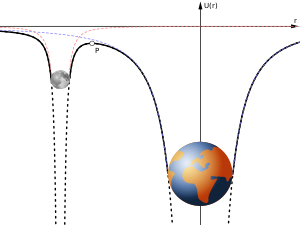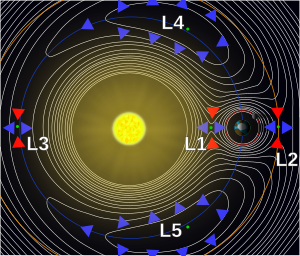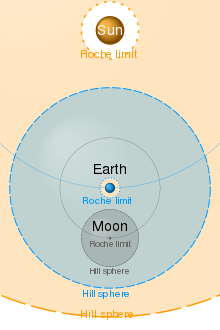Hill sphere
This article has multiple issues.Please helpimprove itor discuss these issues on thetalk page.(Learn how and when to remove these template messages)
|

| Part of a series on |
| Astrodynamics |
|---|
TheHill sphereis a common model for the calculation of agravitational sphere of influence.It is the most commonly used model to calculate the spatial extent of gravitational influence of anastronomical body(m) in which it dominates over the gravitational influence of other bodies, particularly aprimary(M).[1]It is sometimes confused with other models of gravitational influence, such as theLaplace sphere[1]or being called theRoche sphere,the latter causing confusion with theRoche limit.[2][3]It was defined by theAmericanastronomerGeorge William Hill,based on the work of theFrenchastronomerÉdouard Roche.[not verified in body]
To be retained by a more gravitationally attracting astrophysical object—a planet by a more massive star, amoonby a more massive planet—the less massive body must have anorbitthat lies within the gravitational potential represented by the more massive body's Hill sphere.[not verified in body]That moon would, in turn, have a Hill sphere of its own, and any object within that distance would tend to become a satellite of the moon, rather than of the planet itself.[not verified in body]

One simple view of the extent of theSolar Systemis that it is bounded by the Hill sphere of theSun(engendered by the Sun's interaction with thegalactic nucleusor other more massive stars).[4][verification needed]A more complex example is the one at right, the Earth's Hill sphere, which extends between theLagrange pointsL1andL2,[clarification needed]which lie along the line of centers of the Earth and the more massive Sun.[not verified in body]The gravitational influence of the less massive body is least in that direction, and so it acts as the limiting factor for the size of the Hill sphere;[clarification needed]beyond that distance, a third object in orbit around the Earth would spend at least part of its orbit outside the Hill sphere, and would be progressively perturbed by the tidal forces of the more massive body, the Sun, eventually ending up orbiting the latter.[not verified in body]
For two massive bodies with gravitational potentials and any given energy of a third object of negligible mass interacting with them, one can define azero-velocity surfacein space which cannot be passed, the contour of theJacobi integral.[not verified in body]When the object's energy is low, the zero-velocity surface completely surrounds the less massive body (of thisrestricted three-body system), which means the third object cannot escape; at higher energy, there will be one or more gaps or bottlenecks by which the third object may escape the less massive body and go into orbit around the more massive one.[not verified in body]If the energy is at the border between these two cases, then the third object cannot escape, but the zero-velocity surface confining it touches a larger zero-velocity surface around the less massive body[verification needed]at one of the nearby Lagrange points, forming a cone-like point there.[clarification needed][not verified in body]At the opposite side of the less massive body, the zero-velocity surface gets close to the other Lagrange point.[not verified in body]This limiting zero-velocity surface around the less massive body is its Hill "sphere".[according to whom?][original research?]
Definition[edit]
This sectionneeds expansionwith: a comprehensive definition of the title subject, drawn from multiple secondary and tertiary sources, that can be summarised in the lead. You can help byadding to it.(July 2023) |
The Hill radius or sphere (the latter defined by the former radius[citation needed]) has been described as "the region around a planetary body where its own gravity (compared to that of the Sun or other nearby bodies) is the dominant force in attracting satellites," both natural and artificial.[5][better source needed]
As described by de Pater and Lissauer, all bodies within a system such as the Sun'sSolar System"feel the gravitational force of one another", and while the motions of just two gravitationally interacting bodies—constituting a "two-body problem" —are "completely integrable ([meaning]...there exists one independent integral or constraint per degree of freedom)" and thus an exact, analytic solution, the interactions ofthree(or more) such bodies "cannot be deduced analytically", requiring instead solutions by numerical integration, when possible.[6]: p.26 This is the case, unless the negligible mass of one of the three bodies allows approximation of the system as a two-body problem, known formally as a "restricted three-body problem".[6]: p.26
For such two- or restricted three-body problems as its simplest examples—e.g., one more massive primary astrophysical body, mass of m1, and a less massive secondary body, mass of m2—the concept of a Hill radius or sphere is of the approximate limit to the secondary mass's "gravitational dominance",[6]a limit defined by "the extent" of its Hill sphere, which is represented mathematically as follows:[6]: p.29 [7]
- ,
where, in this representation, major axis "a" can be understood as the "instantaneous heliocentric distance" between the two masses (elsewhere abbreviatedrp).[6]: p.29 [7]
More generally, if the less massive body,,orbits a more massive body (m1, e.g., as a planet orbiting around the Sun) and has asemi-major axis,and aneccentricityof,then the Hill radius or sphere,of the less massive body, calculated at thepericenter,is approximately:[8][non-primary source needed][better source needed]
When eccentricity is negligible (the most favourable case for orbital stability), this expression reduces to the one presented above.[citation needed]
Example and derivation[edit]
This sectionneeds additional citations forverification.(December 2023) |

In the Earth-Sun example, the Earth (5.97×1024kg) orbits the Sun (1.99×1030kg) at a distance of 149.6 million km, or oneastronomical unit(AU). The Hill sphere for Earth thus extends out to about 1.5 million km (0.01 AU). The Moon's orbit, at a distance of 0.384 million km from Earth, is comfortably within the gravitationalsphere of influenceof Earth and it is therefore not at risk of being pulled into an independent orbit around the Sun.
The earlier eccentricity-ignoring formula can be re-stated as follows:
- ,or,
where M is the sum of the interacting masses.
Derivation[edit]
The expression for the Hill radius can be found by equating gravitational and centrifugal forces acting on a test particle (of mass much smaller than) orbiting the secondary body. Assume that the distance between massesandis,and that the test particle is orbiting at a distancefrom the secondary. When the test particle is on the line connecting the primary and the secondary body, the force balance requires that
whereis the gravitational constant andis the (Keplerian) angular velocity of the secondary about the primary (assuming that). The above equation can also be written as
which, through a binomial expansion to leading order in,can be written as
Hence, the relation stated above
If the orbit of the secondary about the primary is elliptical, the Hill radius is maximum at theapocenter,whereis largest, and minimum at the pericenter of the orbit. Therefore, for purposes of stability of test particles (for example, of small satellites), the Hill radius at the pericenter distance needs to be considered.
To leading order in,the Hill radius above also represents the distance of the Lagrangian point L1from the secondary.
Regions of stability[edit]
This sectionmay be in need of reorganization to comply with Wikipedia'slayout guidelines.The reason given is:the section lacks sourcing and focus.(July 2023) |
The Hill sphere is only an approximation, and other forces (such asradiation pressureor theYarkovsky effect) can eventually perturb an object out of the sphere.[citation needed]As stated, the satellite (third mass) should be small enough that its gravity contributes negligibly.[6]: p.26ff
Detailed numerical calculations show that orbits at or just within the Hill sphere are not stable in the long term; it appears that stable satellite orbits exist only inside 1/2 to 1/3 of the Hill radius.[citation needed]
The region of stability forretrograde orbitsat a large distance from the primary is larger than the region forprograde orbitsat a large distance from the primary. This was thought to explain the preponderance of retrograde moons around Jupiter; however, Saturn has a more even mix of retrograde/prograde moons so the reasons are more complicated.[10]
Further examples[edit]
This sectionneeds additional citations forverification.(September 2018) |
It is possible for a Hill sphere to be so small that it is impossible to maintain an orbit around a body. For example, an astronaut could not have orbited the 104tonSpace Shuttleat an orbit 300 km above the Earth, because a 104-ton object at that altitude has a Hill sphere of only 120 cm in radius, much smaller than a Space Shuttle. A sphere of this size and mass would be denser thanlead,and indeed, inlow Earth orbit,a spherical body must be more dense than lead in order to fit inside its own Hill sphere, or else it will be incapable of supporting an orbit. Satellites further out ingeostationary orbit,however, would only need to be more than 6% of the density of water to fit inside their own Hill sphere.[citation needed]
Within theSolar System,the planet with the largest Hill radius isNeptune,with 116 million km, or 0.775 au; its great distance from the Sun amply compensates for its small mass relative to Jupiter (whose own Hill radius measures 53 million km). Anasteroidfrom theasteroid beltwill have a Hill sphere that can reach 220,000 km (for1 Ceres), diminishing rapidly with decreasing mass. The Hill sphere of66391 Moshup,aMercury-crossing asteroidthat has a moon (named Squannit), measures 22 km in radius.[11]
A typicalextrasolar"hot Jupiter",HD 209458 b,[12]has a Hill sphere radius of 593,000 km, about eight times its physical radius of approx 71,000 km. Even the smallest close-in extrasolar planet,CoRoT-7b,[13]still has a Hill sphere radius (61,000 km), six times its physical radius (approx 10,000 km). Therefore, these planets could have small moons close in, although not within their respectiveRoche limits.[citation needed]
Hill spheres for the solar system[edit]
The following table and logarithmic plot show the radius of the Hill spheres of some bodies of the Solar System calculated with the first formula stated above (including orbital eccentricity), using values obtained from theJPL DE405 ephemerisand from the NASA Solar System Exploration website.[14]
| Body | Million km | au | Body radii | Arcminutes[note 1] | Farthest moon (au) |
|---|---|---|---|---|---|
| Mercury | 0.1753 | 0.0012 | 71.9 | 10.7 | — |
| Venus | 1.0042 | 0.0067 | 165.9 | 31.8 | — |
| Earth | 1.4714 | 0.0098 | 230.7 | 33.7 | 0.00257 |
| Mars | 0.9827 | 0.0066 | 289.3 | 14.9 | 0.00016 |
| Jupiter | 50.5736 | 0.3381 | 707.4 | 223.2 | 0.1662 |
| Saturn | 61.6340 | 0.4120 | 1022.7 | 147.8 | 0.1785 |
| Uranus | 66.7831 | 0.4464 | 2613.1 | 80.0 | 0.1366 |
| Neptune | 115.0307 | 0.7689 | 4644.6 | 87.9 | 0.3360 |
| Ceres | 0.2048 | 0.0014 | 433.0 | 1.7 | — |
| Pluto | 5.9921 | 0.0401 | 5048.1 | 3.5 | 0.00043 |
| Eris | 8.1176 | 0.0543 | 6979.9 | 2.7 | 0.00025 |

See also[edit]
- Interplanetary Transport Network
- n-body problem
- Roche lobe
- Sphere of influence (astrodynamics)
- Sphere of influence (black hole)
Explanatory notes[edit]
- ^At average distance, as seen from the Sun. Theangular sizeas seen from Earth varies depending on Earth's proximity to the object.
References[edit]
- ^abSouami, D.; Cresson, J.; Biernacki, C.; Pierret, F. (2020)."On the local and global properties of gravitational spheres of influence".Monthly Notices of the Royal Astronomical Society.496(4): 4287–4297.arXiv:2005.13059.doi:10.1093/mnras/staa1520.
- ^Williams, Matt (2015-12-30)."How Many Moons Does Mercury Have?".Universe Today.Retrieved2023-11-08.
- ^Hill, Roderick J. (2022). "Gravitational clearing of natural satellite orbits".Publications of the Astronomical Society of Australia.39.Cambridge University Press.Bibcode:2022PASA...39....6H.doi:10.1017/pasa.2021.62.ISSN1323-3580.S2CID246637375.
- ^Chebotarev, G. A. (March 1965). "On the Dynamical Limits of the Solar System".Soviet Astronomy.8:787.Bibcode:1965SvA.....8..787C.
- ^Lauretta, Dante and the Staff of the Osiris-Rex Asteroid Sample Return Mission (2023)."Word of the Week: Hill Sphere".Osiris-Rex Asteroid Sample Return Mission (AsteroidMission.org).Tempe, AZ: University of Arizona.RetrievedJuly 22,2023.
- ^abcdefde Pater, Imke & Lissauer, Jack (2015). "Dynamics (The Three-Body Problem, Perturbations and Resonances)".Planetary Sciences(2nd ed.). Cambridge, England: Cambridge University Press. pp. 26, 28–30, 34.ISBN9781316195697.Retrieved22 July2023.
{{cite book}}:CS1 maint: multiple names: authors list (link) - ^abHiguchi1, A. & Ida, S. (April 2017)."Temporary Capture of Asteroids by an Eccentric Planet".The Astronomical Journal.153(4). Washington, DC: The American Astronomical Society: 155.arXiv:1702.07352.Bibcode:2017AJ....153..155H.doi:10.3847/1538-3881/aa5daa.S2CID119036212.
{{cite journal}}:CS1 maint: multiple names: authors list (link) CS1 maint: numeric names: authors list (link) - ^Hamilton, D.P. & Burns, J.A. (March 1992)."Orbital Stability Zones About Asteroids: II. The Destabilizing Effects of Eccentric Orbits and of Solar Radiation".Icarus.96(1). New York, NY: Academic Press: 43–64.Bibcode:1992Icar...96...43H.doi:10.1016/0019-1035(92)90005-R.
{{cite journal}}:CS1 maint: multiple names: authors list (link)See alsoHamilton, D.P. & Burns, J.A. (March 1991)."Orbital Stability Zones About Asteroids"(PDF).Icarus.92(1). New York, NY: Academic Press: 118–131.Bibcode:1991Icar...92..118H.doi:10.1016/0019-1035(91)90039-V.Retrieved22 July2023.{{cite journal}}:CS1 maint: multiple names: authors list (link)cited therein. - ^Follows, Mike (4 October 2017)."Ever Decreasing Circles".NewScientist.Retrieved23 July2023.
The moon's Hill sphere has a radius of 60,000 kilometres, about one-sixth of the distance between it and Earth.
- ^Astakhov, Sergey A.; Burbanks, Andrew D.; Wiggins, Stephen & Farrelly, David (2003). "Chaos-assisted capture of irregular moons".Nature.423(6937): 264–267.Bibcode:2003Natur.423..264A.doi:10.1038/nature01622.PMID12748635.S2CID16382419.
- ^Johnston, Robert (20 October 2019)."(66391) MoshupandSquannit ".Johnston's Archive.Retrieved30 March2017.
- ^"HD 209458 b".Extrasolar Planets Encyclopaedia.Archivedfrom the original on 2010-01-16.Retrieved2010-02-16.
- ^"Planet CoRoT-7 b".Extrasolar Planets Encyclopaedia.2024.
- ^"NASA Solar System Exploration".NASA.Retrieved2020-12-22.
Further reading[edit]
- de Pater, Imke & Lissauer, Jack (2015). "Dynamics (The Three-Body Problem, Perturbations and Resonances)".Planetary Sciences(2nd ed.). Cambridge, England: Cambridge University Press. pp. 28–30, 34.ISBN9781316195697.Retrieved22 July2023.
{{cite book}}:CS1 maint: multiple names: authors list (link) - de Pater, Imke & Lissauer, Jack (2015). "Planet Formation (Formation of the Giant Planets, Satellites of Planets and Minor Planets)".Planetary Sciences(2nd ed.). Cambridge, England: Cambridge University Press. pp. 539, 544.ISBN9781316195697.Retrieved22 July2023.
{{cite book}}:CS1 maint: multiple names: authors list (link) - Gurzadyan, Grigor A. (2020). "The Sphere of Attraction, the Sphere of Action and Hill's Sphere".Theory of Interplanetary Flights.Boca Raton, FL: CRC Press. pp. 258–263.ISBN9781000116717.Retrieved22 July2023.
- Gurzadyan, Grigor A. (2020). "The Roche Limit".Theory of Interplanetary Flights.Boca Raton, FL: CRC Press. pp. 263f.ISBN9781000116717.Retrieved22 July2023.
- Ida, S.; Kokubo, E. & Takeda, T. (2012). "N-Body Simulations of Moon Accretion". In Marov, Mikhail Ya. & Rickman, Hans (ed.).Collisional Processes in the Solar System.Astrophysics and Space Science Library. Vol. 261. Berlin, Germany: Springer Science & Business Media. pp. 206, 209f.ISBN9789401007122.Retrieved22 July2023.
{{cite book}}:CS1 maint: multiple names: authors list (link) - Ip, W.-H. & Fernandez, J.A. (2012). "Accretional Origin of the Giant Planers and its Consequences". In Marov, Mikhail Ya. & Rickman, Hans (ed.).Collisional Processes in the Solar System.Astrophysics and Space Science Library. Vol. 261. Berlin, Germany: Springer Science & Business Media. pp. 173f.ISBN9789401007122.Retrieved22 July2023.
{{cite book}}:CS1 maint: multiple names: authors list (link) - Asher, D.J.; Bailey, M.E. & Steel (2012). "The Role of Non-Gravitational Forces in Decoupling Orbits from Jupiter". In Marov, Mikhail Ya. & Rickman, Hans (ed.).Collisional Processes in the Solar System.Astrophysics and Space Science Library. Vol. 261. Berlin, Germany: Springer Science & Business Media. p. 122.ISBN9789401007122.Retrieved22 July2023.
{{cite book}}:CS1 maint: multiple names: authors list (link)

![{\displaystyle R_{\mathrm {H} }\approx a{\sqrt[{3}]{\frac {m_{2}}{3(m_{1}+m_{2})}}}}](https://wikimedia.org/api/rest_v1/media/math/render/svg/eafb3c5ebd5b17a48527cd9d81b5c195a3d584b3)




![{\displaystyle R_{\mathrm {H} }\approx a(1-e){\sqrt[{3}]{\frac {m_{2}}{3(m_{1}+m_{2})}}}.}](https://wikimedia.org/api/rest_v1/media/math/render/svg/c1e1069382b48f1bc5c433a0d8f8691c66ae17d0)













![{\displaystyle {\frac {r_{\mathrm {H} }}{r}}\approx {\sqrt[{3}]{\frac {m}{3M}}}.}](https://wikimedia.org/api/rest_v1/media/math/render/svg/a43f6d6430ee793019c0ef6b03a67acc7ec62513)
